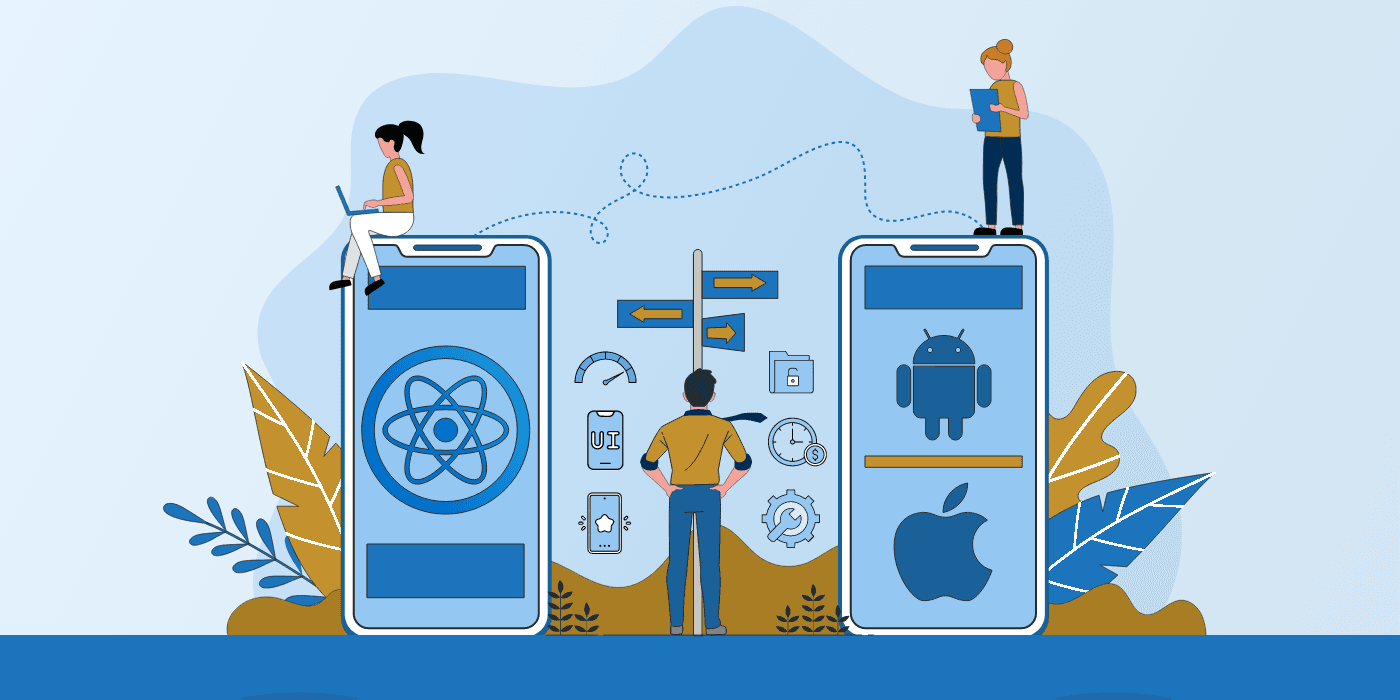React Native App Vs Native App: Five Factors To Consider

Mobile apps have become an indispensable tool to every business operation. However, technical advancements have ensured that mobile apps can be developed in a variety of ways. There are several frameworks, technologies and methodologies that are available to an app developer to choose from. Choosing the right path is very crucial, since changing paths later could be prohibitively expensive.
One fundamental consideration is choosing between native app development and cross-platform development.
Android and iOS are two dominant mobile operating systems in the Mobile Phone landscape. Developing Natively would mean writing code separately for Android or iOS using the software and tools from Google and Apple respectively. But cross-platform framework and tools allows app developers to write code only once and deploy it across multiple platforms including Android and iOS.
Both Native development and Cross Platform development, comes with its pros and cons. Several factors such as below need to be considered:
- purpose and functionality of the app
- time and money available
- performance and other non-functional constraints
- support and maintenance requirements
In this blog we will explore these factors in detail. We hope this will help you decide between Native App Development vs Cross Platform App Development methodology that is most suited for your application.
Performance
Native apps are specifically built and optimized for platforms such as Android or iOS, which generally allows them to offer superior performance compared to cross-platform apps. However, with advancements in hardware and memory capacities, mobile phones now possess the capability to run faster and more substantial applications with ease.
For gaming applications or for apps that are heavily dependent on the device's hardware features, native apps might be the preferred choice. Yet, for the majority of business applications, the performance discrepancy between native and cross-platform apps is minimal. Indeed, highly popular applications like Instagram, developed using cross-platform technologies, have demonstrated performance on par with their native counterparts.
Verdict: While native apps may offer better performance over cross-platform apps, the difference is often negligible for most general applications.
User Interface
Android and iOS share some design principles, but adopt markedly different styles and methodologies regarding User Interface (UI). This difference becomes apparent when Android users switch to an iPhone, or vice versa, as it often requires time to adjust to the contrasting design ethos.
Business owners face two main approaches when considering Mobile UI/UX Design:
- Platform-Specific Design: UI design is tailored separately for each platform, ensuring perfect alignment with the distinct aesthetic and functional expectations of each.
- Uniform Design: A single, unified UI design is applied across all platforms, aiming to provide a seamless user experience regardless of the device.
Native apps, developed exclusively for a particular platform, offer UIs that harmonize with platform-specific conventions, delivering optimal User Experience (UX).
Conversely, the advantage of cross-platform apps lies in their ability to develop common, reusable components for use across different platforms. While frameworks like React Native can natively render UI elements (e.g., buttons) and adapt them to the platform, they are generally better suited for creating apps with a Uniform Design. These apps maintain a consistent look and feel across Android and iOS.
Verdict: Native apps possess a distinct advantage in terms of UI design that conforms to platform-specific guidelines. However, for applications requiring a seamless user experience across different platforms, cross-platform development emerges as the more fitting choice.
Availability of latest features
Both Android and iOS ecosystems are dynamic, with frequent version updates that introduce new features or refine existing ones. This constant evolution ensures that users have access to the latest functionalities and experiences. However, when using a cross-platform framework like React Native, there’s an inherent lag between when these new features are introduced on native platforms and when they become available on the framework.
The Lag: An Issue, But Not a Deal-breaker
At first glance, this delay might seem like a drawback. However, it often doesn’t pose a significant barrier due to several mitigating factors:
Responsive Community: Cross Platform frameworks like React Native is supported by a vibrant and proactive developer community. When new features are released on Android or iOS, community developers quickly take action to integrate these advancements into the framework. This ensures that React Native developers can catch up without substantial delay.
The Wisdom of Waiting: Immediate adoption of new features can be tempting, but waiting for these features to mature and stabilize is often a wiser approach. Early adopters can encounter unexpected issues, whereas a brief waiting period allows for a clearer understanding of any potential problems and their solutions. This patience facilitates smoother integration into production apps
Verdict: When it comes to new platform feature availability on cross-platform, there is a slight lag, but is not a major impediment in most cases.
Development Time & Cost
Cross-platform frameworks, such as React Native, provide the efficiency of writing code once and deploying it across multiple platforms, including Android and iOS. This approach significantly reduces both development time and costs.
Conversely, native app development, require developing two separate apps: one for Android and one for iOS. Each platform requires its own specific development environment, language and tools. This necessitates separate sets of developers with distinct skill sets for each app, thus increasing the overall cost.
Furthermore, cross-platform frameworks like React Native are rooted in the JavaScript programming language, which can be universally applied in mobile, web, and backend development. This versatility means that the skill set for cross-platform development is more readily available and can be utilised across the entire development stack.
Verdict: When it comes to optimising cost and time, Cross Platform frameworks have a clear edge over Native app development.
Maintenance and Support
Cross platform development offers significant advantages when it comes to support and maintenance of the final product. As previously mentioned, cross-platform frameworks utilise a unified code base to develop apps for both android and iOS. This approach allows for issues to be fixed and enhancements to be implemented on the same code base for both platforms, streamlining the maintenance process. It not only reduces the overall cost and effort required for upkeep, but also ensures consistent code across the platforms.
On the other hand, native app development involves maintaining separate code bases for Android and iOS. Although this method, allows for platform-specific optimizations, it also poses few challenges. As updates are made and features are introduced, there’s an inherent risk of these code bases diverging, leading to potential inconsistencies between app versions on different platforms over time. Furthermore, maintaining and supporting native apps requires distinct skill sets for each platform, significantly increasing maintenance costs.
Verdict: When considering the efforts and costs associated with maintenance, cross-platform frameworks, with their unified code base, offer a clear advantage over native apps.
Conclusion
Cross Platform development and Native App development are two distinct approaches to mobile app development. The optimal choice for your project, depends on variety of considerations including your applications type and purpose, customer expectations, budgetary and time constraints and your long term strategic goals.
In this blog we have delved into several critical aspects, such as, Performance, User Interface (UI) and User Experience (UX), adaptability to new feature releases, development time and cost and app maintainability.
Our aim is to provide you with a deeper understanding of each approach's nuances, enabling you to make a well-informed decision that paves the way for your app's success. Should you be eager to further explore your app concept, do not hesitate to reach out to us at app@appilytech.com. Let's embark on your app development journey together.
Contact Us
You Might Be Interested

Technology
Top Four Benefits Of A React Native Mobile App
Explore the key benefits of React Native for mobile apps: Native Performance, Cross Platform methodology, robust ecosystem and seamless full stack integration.

APPiLY Info
Our Six-Step App Development Process
Explore our efficient 6-step app development process—ideation, planning, development, testing, launch, and support—consistently delivering superior-quality apps